Abstract
We examined the efficacy of a Chlamydia trachomatis DNA probe in detecting ocular chlamydiae by comparing it with tissue culture isolation, direct fluorescent-antibody cytology, and clinical eye exams. In a trachoma-endemic area of Nepal, 430 Nepalese villagers were examined according to the World Health Organization trachoma grading scale. Upper tarsal conjunctival specimens from each subject were obtained for DNA probing, tissue culture, and fluorescent-antibody screening. Moderate to severe intensity of inflammation was found in 85 (21%) of 430 people studied. An additional 25 (7.2%) of 345 people with low or no intensity of inflammation also had microbiologically proven infection, which may reflect asymptomatic carriage. Compared with culture, the DNA probe had a sensitivity of 86.9% and a specificity of 91%. For direct fluorescent antibody versus culture, the values were 47.8 and 96.9%, respectively. Results from this study indicate that the DNA probe for C. trachomatis might be considered a valuable epidemiologic tool in screening trachoma-endemic populations for ocular chlamydiae.
Full text
PDF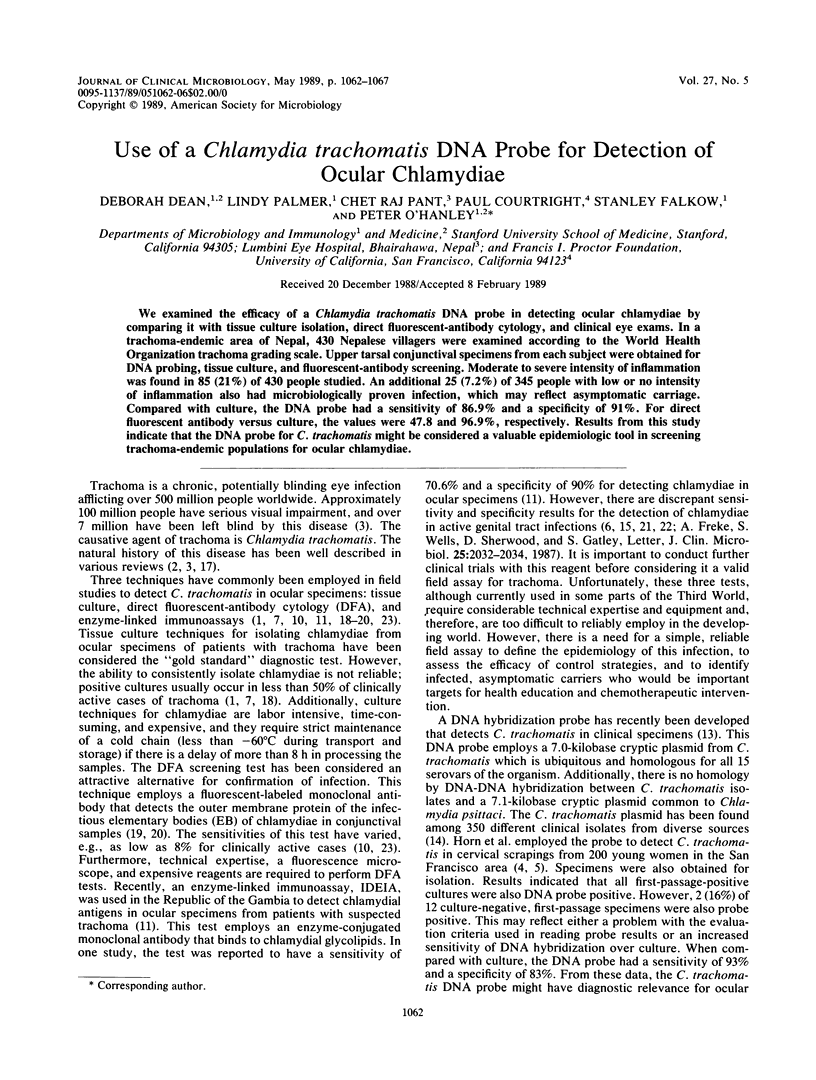
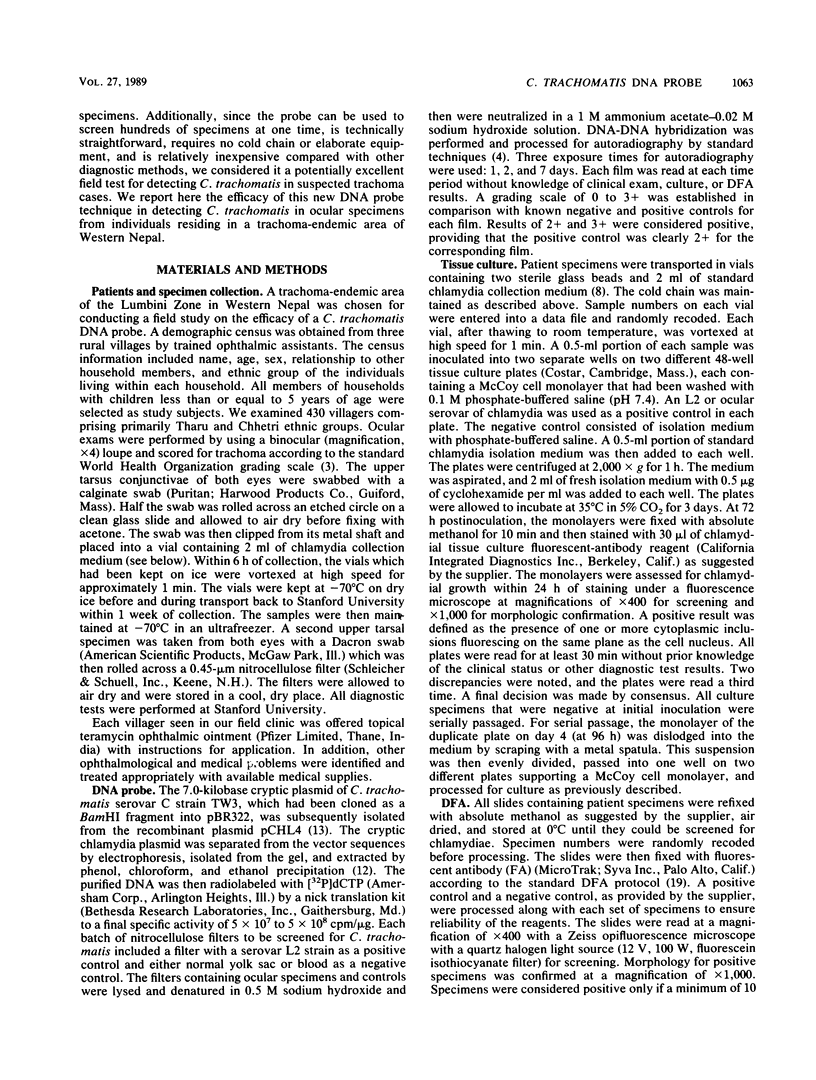
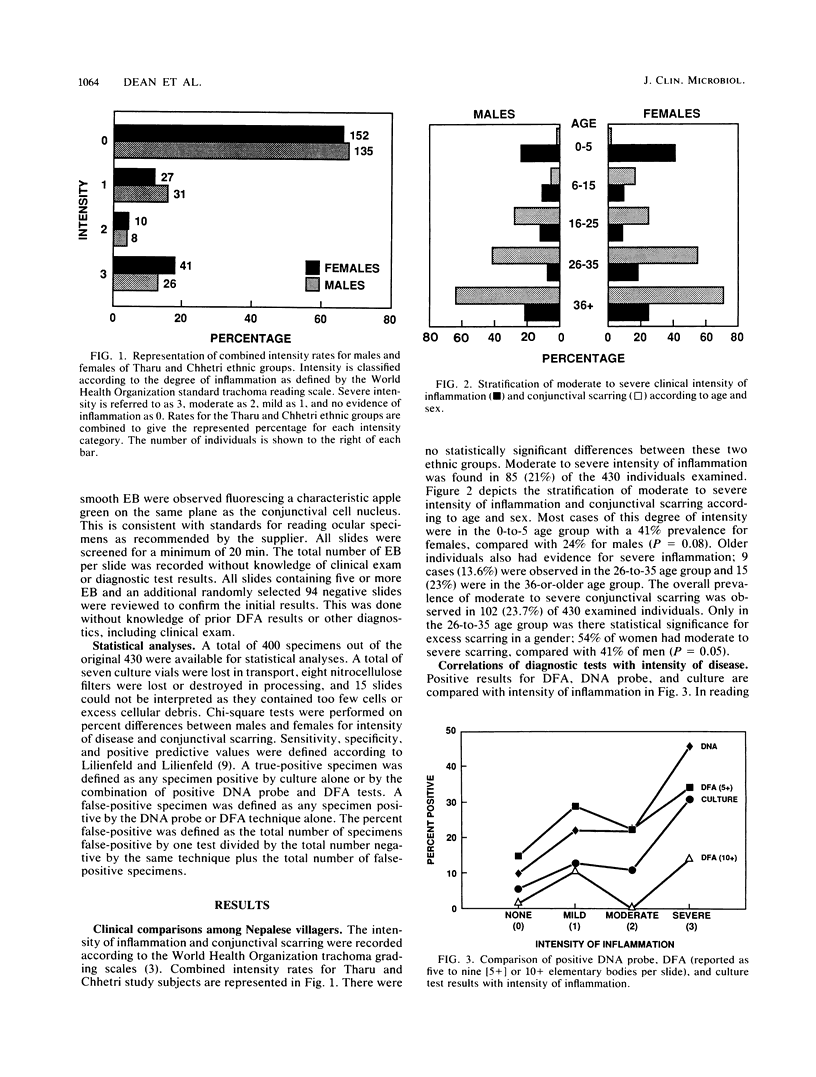
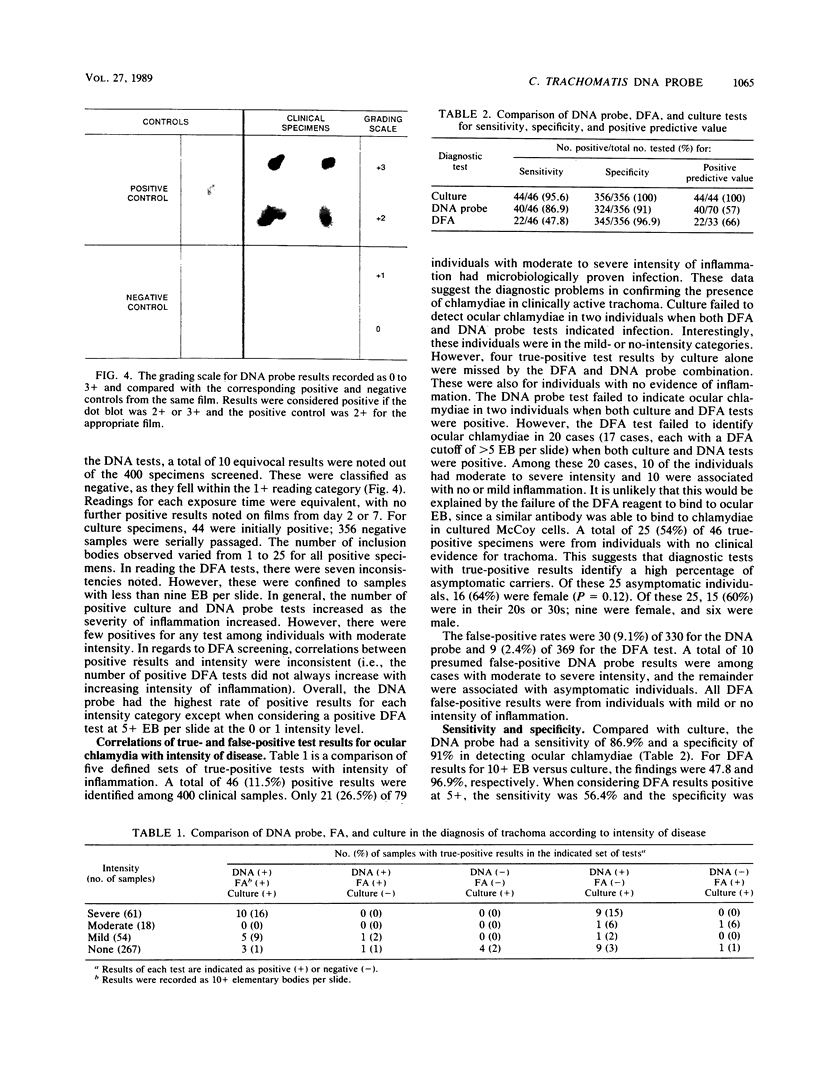
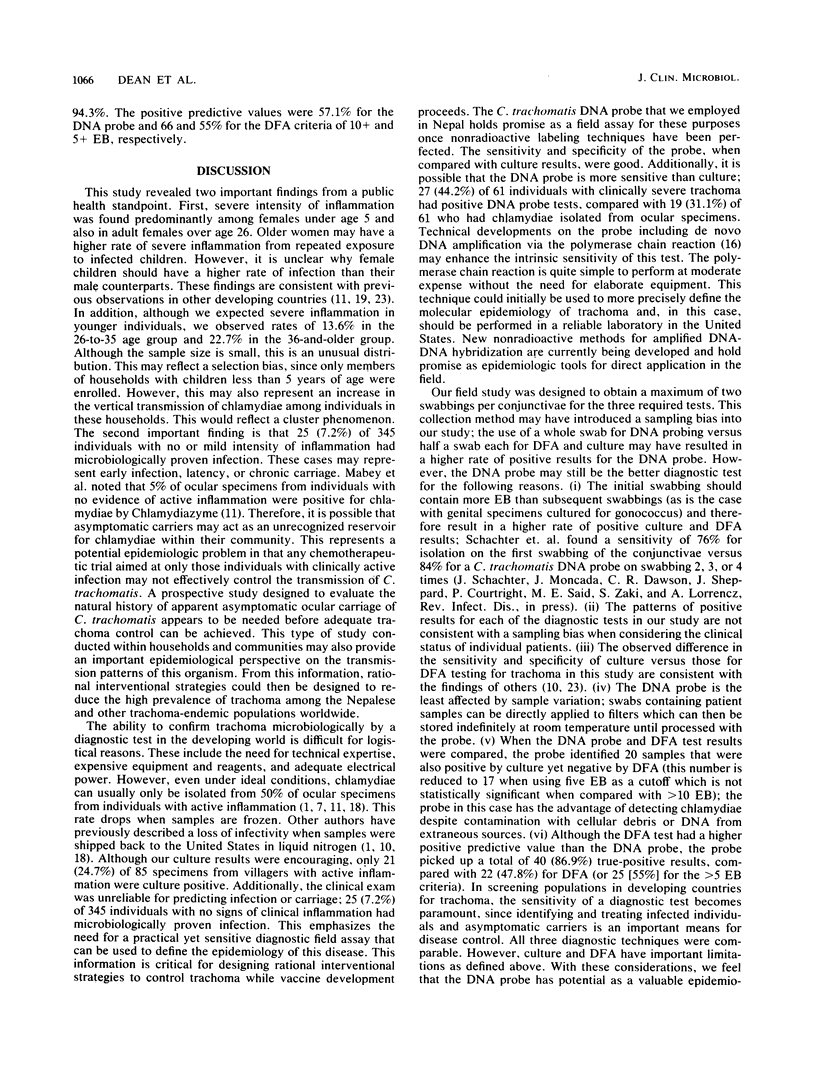
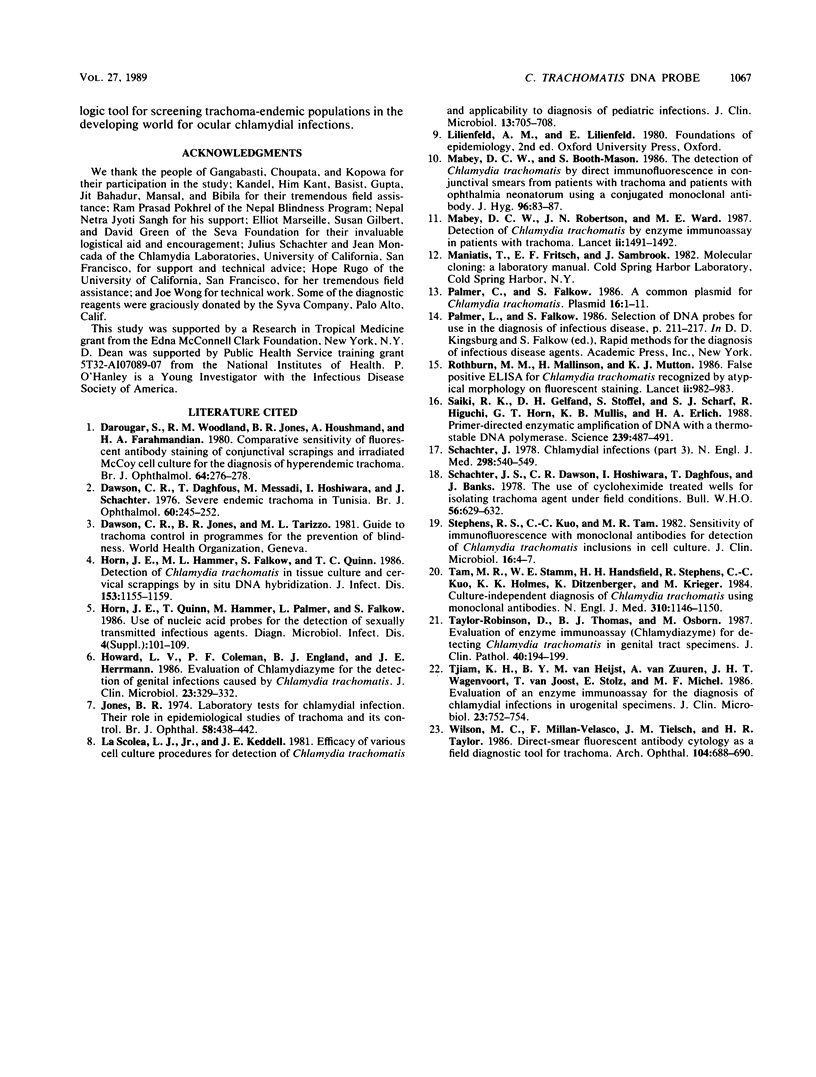
Images in this article
Selected References
These references are in PubMed. This may not be the complete list of references from this article.
- Darougar S., Woodland R. M., Jones B. R., Houshmand A., Farahmandian H. A. Comparative sensitivity of fluorescent antibody staining of conjunctival scrapings and irradiated McCoy cell culture for the diagnosis of hyperendemic trachoma. Br J Ophthalmol. 1980 Apr;64(4):276–278. doi: 10.1136/bjo.64.4.276. [DOI] [PMC free article] [PubMed] [Google Scholar]
- Dawson C. R., Daghfous T., Messadi M., Hoshiwara I., Schachter J. Severe endemic trachoma in Tunisia. Br J Ophthalmol. 1976 Apr;60(4):245–252. doi: 10.1136/bjo.60.4.245. [DOI] [PMC free article] [PubMed] [Google Scholar]
- Grandi G., Del Bue M., Palla E., Mele A., Colletti E., Toma S. New plasmid expression vectors for Bacillus subtilis. Plasmid. 1986 Jul;16(1):1–14. doi: 10.1016/0147-619x(86)90074-0. [DOI] [PubMed] [Google Scholar]
- Horn J. E., Hammer M. L., Falkow S., Quinn T. C. Detection of Chlamydia trachomatis in tissue culture and cervical scrapings by in situ DNA hybridization. J Infect Dis. 1986 Jun;153(6):1155–1159. doi: 10.1093/infdis/153.6.1155. [DOI] [PubMed] [Google Scholar]
- Howard L. V., Coleman P. F., England B. J., Herrmann J. E. Evaluation of chlamydiazyme for the detection of genital infections caused by Chlamydia trachomatis. J Clin Microbiol. 1986 Feb;23(2):329–332. doi: 10.1128/jcm.23.2.329-332.1986. [DOI] [PMC free article] [PubMed] [Google Scholar]
- Jones B. R. Laboratory tests for chlamydial infection. Their role in epidemiological studies of trachoma and its control. Br J Ophthalmol. 1974 Apr;58(4):438–454. doi: 10.1136/bjo.58.4.438. [DOI] [PMC free article] [PubMed] [Google Scholar]
- La Scolea L. J., Jr, Keddell J. E. Efficacy of various cell culture procedures for detection of Chlamydia trachomatis and applicability to diagnosis of pediatric infections. J Clin Microbiol. 1981 Apr;13(4):705–708. doi: 10.1128/jcm.13.4.705-708.1981. [DOI] [PMC free article] [PubMed] [Google Scholar]
- Mabey D. C., Booth-Mason S. The detection of Chlamydia trachomatis by direct immunofluorescence in conjunctival smears from patients with trachoma and patients with ophthalmia neonatorum using a conjugated monoclonal antibody. J Hyg (Lond) 1986 Feb;96(1):83–87. doi: 10.1017/s0022172400062562. [DOI] [PMC free article] [PubMed] [Google Scholar]
- Mabey D. C., Robertson J. N., Ward M. E. Detection of Chlamydia trachomatis by enzyme immunoassay in patients with trachoma. Lancet. 1987 Dec 26;2(8574):1491–1492. doi: 10.1016/s0140-6736(87)92623-7. [DOI] [PubMed] [Google Scholar]
- Rothburn M. M., Mallinson H., Mutton K. J. False-positive ELISA for Chlamydia trachomatis recognised by atypical morphology on fluorescent staining. Lancet. 1986 Oct 25;2(8513):982–983. doi: 10.1016/s0140-6736(86)90637-9. [DOI] [PubMed] [Google Scholar]
- Saiki R. K., Gelfand D. H., Stoffel S., Scharf S. J., Higuchi R., Horn G. T., Mullis K. B., Erlich H. A. Primer-directed enzymatic amplification of DNA with a thermostable DNA polymerase. Science. 1988 Jan 29;239(4839):487–491. doi: 10.1126/science.2448875. [DOI] [PubMed] [Google Scholar]
- Schachter J. Chlamydial infections (third of three parts). N Engl J Med. 1978 Mar 9;298(10):540–549. doi: 10.1056/NEJM197803092981005. [DOI] [PubMed] [Google Scholar]
- Schachter J., Dawson C. R., Hoshiwara I., Daghfous T., Banks J. The use of cycloheximide-treated cells for isolating trachoma agents under field conditions. Bull World Health Organ. 1978;56(4):629–632. [PMC free article] [PubMed] [Google Scholar]
- Stephens R. S., Kuo C. C., Tam M. R. Sensitivity of immunofluorescence with monoclonal antibodies for detection of Chlamydia trachomatis inclusions in cell culture. J Clin Microbiol. 1982 Jul;16(1):4–7. doi: 10.1128/jcm.16.1.4-7.1982. [DOI] [PMC free article] [PubMed] [Google Scholar]
- Tam M. R., Stamm W. E., Handsfield H. H., Stephens R., Kuo C. C., Holmes K. K., Ditzenberger K., Krieger M., Nowinski R. C. Culture-independent diagnosis of Chlamydia trachomatis using monoclonal antibodies. N Engl J Med. 1984 May 3;310(18):1146–1150. doi: 10.1056/NEJM198405033101803. [DOI] [PubMed] [Google Scholar]
- Taylor-Robinson D., Thomas B. J., Osborn M. F. Evaluation of enzyme immunoassay (Chlamydiazyme) for detecting Chlamydia trachomatis in genital tract specimens. J Clin Pathol. 1987 Feb;40(2):194–199. doi: 10.1136/jcp.40.2.194. [DOI] [PMC free article] [PubMed] [Google Scholar]
- Tjiam K. H., van Heijst B. Y., van Zuuren A., Wagenvoort J. H., van Joost T., Stolz E., Michel M. F. Evaluation of an enzyme immunoassay for the diagnosis of chlamydial infections in urogenital specimens. J Clin Microbiol. 1986 Apr;23(4):752–754. doi: 10.1128/jcm.23.4.752-754.1986. [DOI] [PMC free article] [PubMed] [Google Scholar]
- Wilson M. C., Millan-Velasco F., Tielsch J. M., Taylor H. R. Direct-smear fluorescent antibody cytology as a field diagnostic tool for trachoma. Arch Ophthalmol. 1986 May;104(5):688–690. doi: 10.1001/archopht.1986.01050170078026. [DOI] [PubMed] [Google Scholar]



